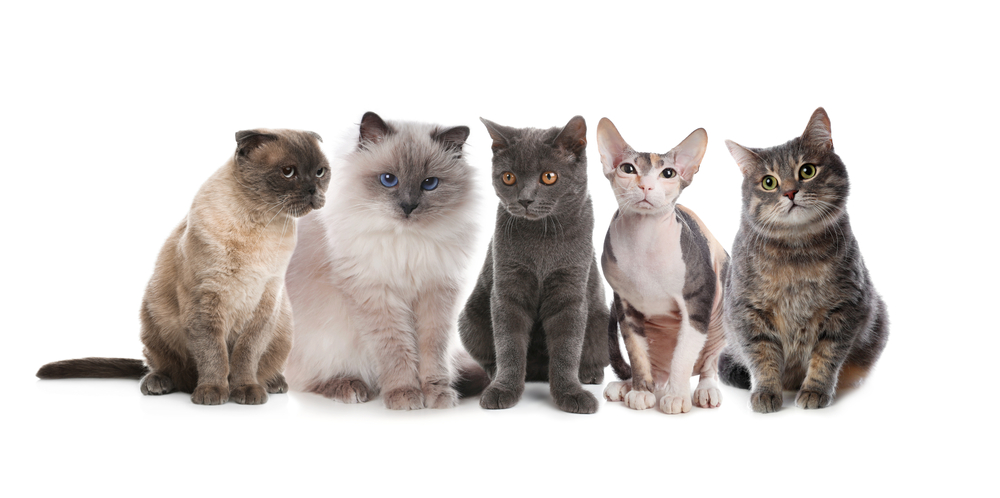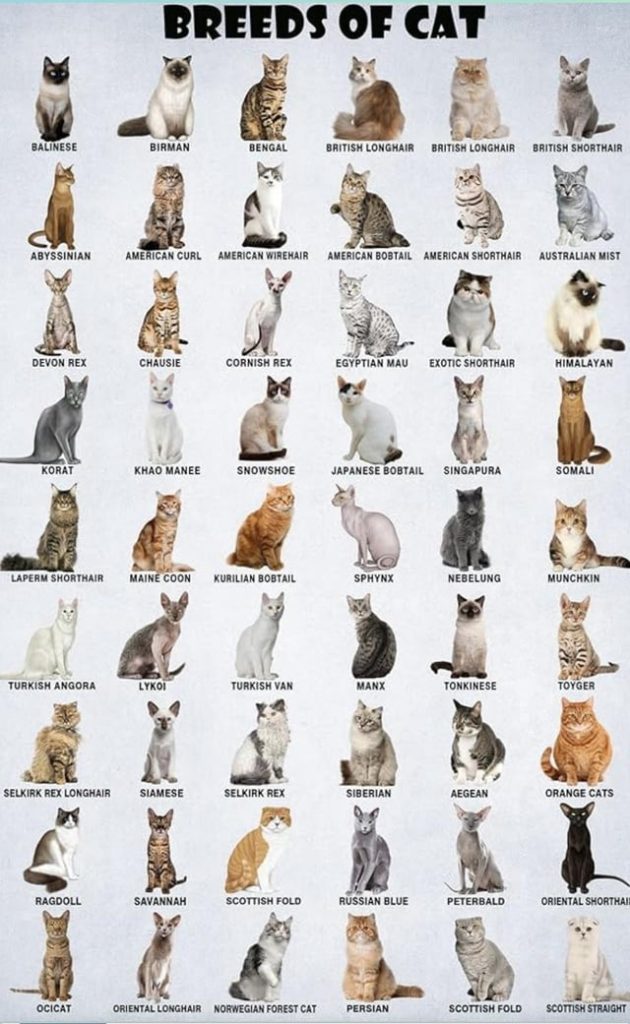Have you ever looked at your feline friend and wondered about their breed? You might be curious about their unique features or characteristics that make them stand out.
Understanding a cat’s breed can help you better appreciate their behavior, health needs, and even the way they play. This guide will reveal how you can identify your cat’s breed, using simple observations and helpful tips. Imagine the joy of discovering more about your beloved pet, and how this knowledge can deepen your connection with them.
Dive in to uncover the secrets that will help you recognize the breed of your cat with ease and clarity.
Physical Characteristics
Identifying a cat’s breed involves observing distinct physical traits. Notice the cat’s fur length, color, and pattern. Eye shape and ear size also provide clues. Tail length and body size can hint at specific breeds. Understanding these features aids in recognizing different cat breeds.
Understanding your cat’s breed can be both fascinating and insightful. Physical characteristics offer the first clues in identifying your feline friend’s lineage. By focusing on specific features, you can narrow down the possibilities and appreciate the unique traits your cat possesses.
Coat Patterns And Colors
A cat’s coat is one of the most distinctive features. Some breeds have solid colors, while others boast intricate patterns. Does your cat have the classic tabby stripes or a solid, sleek coat? Consider the colors too. Siamese cats, for example, are known for their striking cream bodies with dark points. The Bengal cat, on the other hand, often has a leopard-like spotted coat. Observing these details can provide significant hints about your cat’s heritage.
Eye Shape And Color
Eyes can be a window into your cat’s breed. Notice the shape and color of your cat’s eyes. Persian cats typically have large, round eyes, often in shades of blue or copper. In contrast, the Abyssinian cat has almond-shaped eyes, usually green or gold. Have you ever looked at your cat’s eyes and wondered about their origin?
Body Structure And Size
Body structure and size can also reveal a lot about a cat’s breed. Is your cat long and slender like a Siamese, or more robust and muscular like a Maine Coon? Breed-specific traits like ear shape and tail length also offer clues. For instance, Scottish Folds have distinct folded ears, while the Manx cat is known for its tailless appearance. Pay attention to these characteristics; they are the puzzle pieces that complete the picture of your cat’s breed identity. By examining these physical traits, you gain not only insights into your cat’s background but also a deeper connection with your furry companion. Have you noticed any of these traits in your cat?
Behavioral Traits
Different cat breeds display unique behavioral traits. Siamese cats often seek attention, while Maine Coons tend to be independent. Observing these behaviors helps identify a cat’s breed, offering insights into their personality and preferences.
Determining a cat’s breed isn’t just about physical appearance. Their behavior can offer subtle clues. Cats exhibit various behavioral traits that can help identify their breed. Understanding these traits can be a fun and insightful way to get to know your feline friend better.
Activity Levels
Some cats are like a whirlwind of energy, while others prefer lounging around all day. If your cat frequently zips around the room, it might belong to a more active breed like the Bengal. These cats love to explore and climb. On the other hand, a Persian cat might spend more time basking in the sun with a relaxed demeanor. Consider how your cat spends its days. Does it seem to have endless energy or a calm, laid-back attitude?
Social Tendencies
Your cat’s interaction with people and other animals can offer hints about its breed. Siamese cats are known for their sociable nature. They often follow their owners around, seeking attention. If your cat behaves like a shadow, it might have Siamese ancestry. Conversely, breeds like the Russian Blue may prefer more solitude and quiet, observing interactions from a safe distance. Think about your cat’s social habits. Does it crave company or enjoy its privacy?
Vocalization Patterns
Some cats are chatterboxes, while others communicate with silence. Siamese cats are famously vocal, expressing themselves with a range of sounds. If your home echoes with meows, you might have a Siamese. In contrast, British Shorthairs are more reserved, often communicating through subtle gestures. Listen to your cat’s voice. Is it loud and frequent, or quiet and rare? These sounds can be clues to their heritage. Understanding these behavioral traits can help you connect more deeply with your cat and appreciate its unique personality. By observing these traits, you might uncover fascinating insights into your cat’s breed. What does your cat’s behavior say about its origins?
Genetic Testing
Genetic testing helps identify a cat’s breed by analyzing its DNA. This method is precise and reveals unique traits. Understanding your cat’s genetic makeup can also provide insights into health and behavior.
Genetic testing offers a scientific approach to identifying a cat’s breed. This method uses advanced technology to analyze a cat’s DNA. With genetic testing, you can gain insights into your cat’s ancestry. It’s a fascinating way to learn more about your feline friend.
Dna Analysis
DNA analysis examines the genetic material of your cat. This process identifies specific breed markers. These markers help determine your cat’s breed mix. Testing kits are available online or through veterinarians. You collect a sample, often a cheek swab, and send it to a lab. Results reveal the genetic composition of your cat. This can include primary and secondary breeds.
Benefits Of Genetic Testing
Genetic testing provides valuable information. It helps in understanding your cat’s health risks. Certain breeds may have genetic predispositions. Knowing these can guide healthcare decisions. It also enhances the bond with your cat. Knowing their breed can be fascinating and informative. It adds depth to your relationship.
Limitations And Considerations
Genetic testing has its limitations. Results may not be 100% accurate. Some breeds share similar genetic markers. This can confuse the analysis. Also, not all breeds are in the database. This may result in incomplete data. Consider the cost as well. Testing can be expensive. Weigh the benefits against the limitations.

Credit: www.ovrs.com
Breed-specific Traits
Understanding a cat’s breed can offer insights into its behavior, health, and care needs. Breed-specific traits often reveal distinctive features that make each breed unique. By recognizing these traits, you can better understand your feline friend. From their physical characteristics to their grooming needs, every detail matters.
Distinctive Features
Each cat breed boasts unique physical traits. Maine Coons are large with tufted ears. Siamese cats have striking blue eyes and sleek bodies. Persian cats are known for their long, fluffy coats and flat faces. Look for these features to identify your cat’s breed.
Common Health Issues
Different breeds may face specific health challenges. Persians often have respiratory issues due to their flat faces. Siamese cats can be prone to dental problems. Maine Coons may have heart conditions. Knowing these issues helps in providing proper care.
Grooming Requirements
Grooming needs vary by breed. Long-haired breeds like Persians require regular brushing to prevent matting. Short-haired breeds like the Siamese need less frequent grooming. Maine Coons need moderate grooming to maintain their thick coats. Understand these requirements for a healthy, happy cat.
Consulting Experts
Identifying a cat’s breed requires expert insights. While online resources can help, consulting experts offers precise answers. Experts provide valuable information based on years of experience. Their guidance ensures you understand your cat’s unique traits and characteristics.
Veterinarian Insights
Veterinarians possess deep knowledge of cat breeds. They can identify specific breed traits effectively. Their experience with various breeds allows them to notice subtle differences. A vet examines physical features like fur texture and ear shape. They also consider behavioral tendencies unique to each breed. Consulting a vet helps confirm your cat’s breed accurately.
Cat Breeder Advice
Cat breeders specialize in specific breeds. They have firsthand knowledge of breed standards. Breeders can identify traits that distinguish one breed from another. They provide insights into the breed’s history and personality. Speaking with a breeder can offer clarity on your cat’s lineage. They often have resources to trace your cat’s family tree.
Cat Show Observations
Cat shows are great places to learn about breeds. Experts judge cats based on breed standards. Observing these shows provides a visual guide to identifying breeds. You can see how experts differentiate between similar breeds. Attending shows can give you insights into your cat’s breed traits. It’s a chance to meet breeders and judges who can offer advice.

Credit: www.reddit.com
Resources For Identification
Identifying your cat’s breed can be an exciting and rewarding journey. Whether you’re curious about the unique traits of your feline friend or simply want to know more about their heritage, there are resources that can help. By using a variety of tools, you can gather clues and make an informed guess about your cat’s lineage. Below are some practical resources to guide you on this detective-like quest.
Books And Guides
Books and guides are a treasure trove of information for anyone looking to identify their cat’s breed. Many cat enthusiasts recommend starting with comprehensive guides like “The Cat Fanciers’ Association Complete Cat Book” or “The Encyclopedia of Cat Breeds”. These books offer detailed descriptions, photographs, and breed histories.
Visiting your local library or bookstore can unearth other gems. Don’t underestimate the value of old-fashioned reading. Sometimes, the tactile experience of flipping through pages and comparing images can lead to that “aha” moment of breed recognition.
Online Databases
In our digital age, online databases have become an indispensable resource. Websites like The International Cat Association (TICA) and the Cat Fanciers’ Association (CFA) provide extensive online breed directories. These platforms often include photos, breed standards, and even personality traits.
One personal tip is to use these databases in conjunction with image search engines. Upload a photo of your cat and see if it matches any breed images online. It’s a fun and interactive way to explore possibilities and can sometimes yield surprising results.
Breed Clubs And Organizations
Joining breed clubs and organizations can offer a community-driven approach to identifying your cat’s breed. These clubs often provide forums, newsletters, and events where you can connect with other cat owners and experts. Engaging with these communities can provide insights that you won’t find in books or online.
Consider reaching out to local breed clubs for guidance or attending cat shows in your area. Seeing different breeds firsthand and speaking with breeders can provide clarity and potentially uncover the mystery of your cat’s ancestry.
Have you ever thought about joining a cat community to learn more about your feline? You might discover not only your cat’s breed but also a community of like-minded cat lovers.
Identifying your cat’s breed is not just about labels; it’s about understanding the unique characteristics that make your feline friend special. With these resources, you’ll be well-equipped to embark on this fascinating journey.
:max_bytes(150000):strip_icc()/black-white-cat-on-lap-dpddm-JD-913-2000-9ba4ae3a902544d88af9f7ded6d7fe0c.jpg)
Credit: www.dailypaws.com
Frequently Asked Questions
How Do I Tell What Breed My Cat Is?
Identify your cat’s breed by examining its physical traits, such as fur type, color, and body structure. Compare these traits with breed characteristics online or consult a veterinarian for help. Genetic testing kits can provide a more accurate determination of your cat’s breed.
How Can I Identify A Cat?
Identify a cat by its distinctive whiskers, triangular ears, and retractable claws. Cats usually have soft fur and a flexible body. Look for a tail that balances their movements. Their eyes are generally round with vertical slits. Cats often exhibit playful and curious behavior.
Can Google Lens Identify Cat Breeds?
Google Lens can identify cat breeds using image recognition technology. It analyzes photos to provide breed information. Results may vary based on image quality and breed distinctiveness. Always consult a vet or expert for precise identification.
What Is The 1 Smartest Cat?
The Abyssinian cat is often considered the smartest cat breed. They are highly curious, active, and enjoy learning new tricks. Abyssinians are known for their playful nature and problem-solving skills, making them incredibly intelligent companions. Their intelligence requires mental stimulation through interactive toys and games.
Conclusion
Identifying your cat’s breed can be fun and rewarding. Pay attention to their size, fur, and markings. These features often reveal breed clues. Check their eye color and shape, too. It helps narrow down possibilities. Don’t forget, behavior can hint at breed traits.
Consult a vet or use breed identification tools if unsure. Enjoy the journey of discovering your cat’s heritage. Understanding your cat better strengthens your bond. This knowledge also aids in providing proper care. Remember, each cat is unique and special, regardless of breed.
Your furry friend’s individuality is what truly matters.
